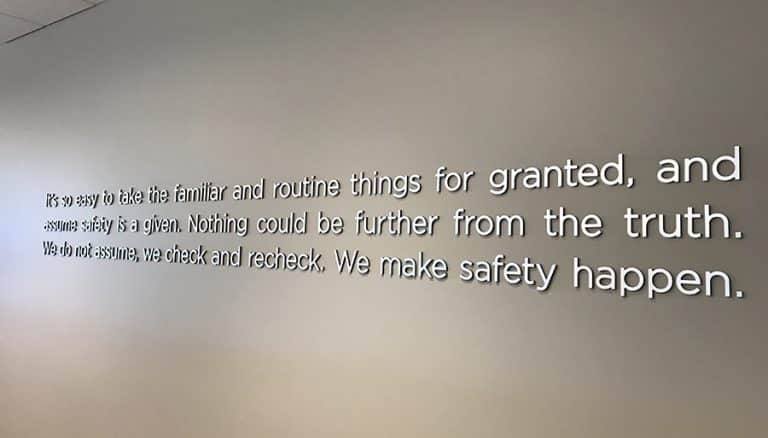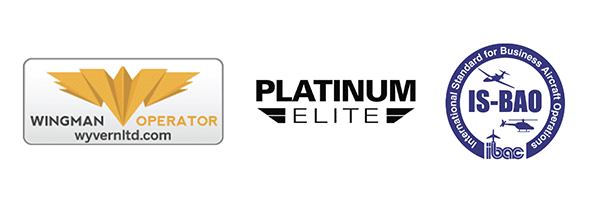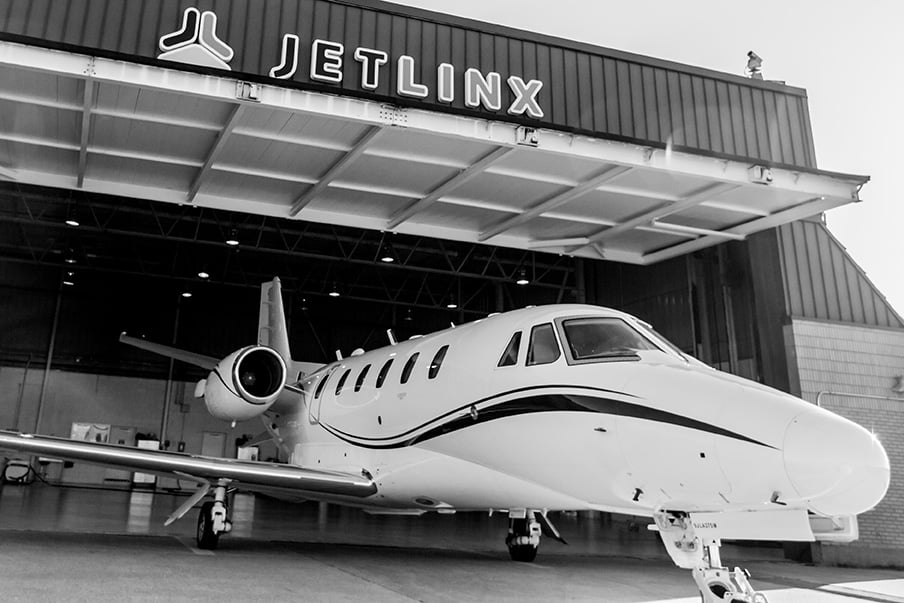Jet Linx Continues to Soar Above Industry Safety Standards
As the foundational principle of our culture and values, safety remains the bedrock of success at Jet Linx.
Despite a persistent global pandemic and a rapidly shifting industry, the safety management system (SMS) at Jet Linx continues to redefine best practices in the industry, turning challenging obstacles into new learning opportunities.
Recent developments, such as Jet Linx earning the first-ever ARGUS Platinum Elite rating and actively working toward the new Wyvern Wingman Pro rating, point to a dynamic safety culture of continuing improvement fed by a system of continuous monitoring. The Jet Linx SMS is designed to assess and manage planned changes in safety and to control potential quality escapes. This is accomplished by various programs and systems, but also through regular internal evaluations, hands-on practice conducting risk assessments, monthly Base safety audits and Base facility security reviews that include necessary investments to enhance safety.
“At Jet Linx, safety is not just lip service. Our leadership invests substantially into training and implementation. But more importantly, they listen to our safety team when changes need to be made or situations arise that need to be addressed quickly,” explained RD Johnson, Jet Linx Director of Safety.
Johnson joined Jet Linx in September 2021 from Global Flight Test and Delivery Group (GFT&D), where he was responsible for delivering customized SMS business solutions for commercial, business and private operators. Bringing extensive leadership experience, Johnson’s career spans flight operations, technical ops, employee development, process improvement and safety management across the military, commercial and general aviation sectors. After graduating from the United States Air Force, Johnson served for 31 years as a Command Pilot in the U.S. Air Force Reserves and he also after retired from American Airlines where he worked for 34 years. He continues to instruct at the University of Southern California at their Aviation Safety and Security School.
“To put it frankly, I would not have joined Jet Linx if I had not been impressed with the safety culture or the safety management system in place. The participation in ARGUS, Wyvern, IS-BAO and NBAA programs clearly put Jet Linx at the top of the industry, but I was most impressed with the annual all-team Jet Linx Safety Summit. That is a rare and genuine display of dedication to safety that very few other organizations have the time, talent, or desire to undertake,” Johnson said.
The Three Legs of Safety at Jet Linx
If you’re not a professional involved in safety management, the terminology and use of acronyms can feel abstract. It is first important to understand that safety management must exist in a ‘just culture’ world. This means that safety management systems do not revolve around finger-pointing and assigning blame. Modern approaches to safety utilize root cause analysis to pinpoint where issues stem from, and then coaching and retraining are conducted to reduce and eliminate hazards.
“I like to compare our safety program to a three-legged stool buttressed by three systems: the Aviation Safety Action Program (ASAP), Flight Operations Quality Assurance (FOQA) and Line Operating Safety Audits (LOSA). All three systems remain equally important to the integrity of our safety management system,” Johnson explained.
The ASAP functions as a proactive, voluntary self-reporting of safety occurrences and situations to the Federal Aviation Administration (FAA) certificate holder. All Jet Linx team members are encouraged to make ASAP reports and/or Hazard reports to reduce hazards and improve training. Not every Part 135 Operator has an ASAP. Jet Linx has a particularly robust ASAP, with roughly 75% of Jet Linx pilots contributing to the program. This voluntary reporting fosters a culture of continuous improvement without fear of retribution or other negative outcomes.
For example, if a person noticed that the paint on an airport taxiway had been applied incorrectly, or perhaps some signage was incorrect, they should file an ASAP report. ASAP reporting offers an opportunity to report mistakes or incidents proactively. When an ASAP report is filed and accepted, the most likely outcomes are further training and coaching.
The FOQA program encompasses data collection – typically through flight data recorders or other means. A FOQA program allows tremendously precise data to be collected that can reveal everything that occurred during a flight, down to which controls were touched at what time. Data such as airspeed, temperature, altitude and other information can be used to study how a flight unfolded. The objective of this data collection is not for punitive purposes, but more for quality control.

An example would be when FOQA data reveals that a Challenger 604 was flying at 0.84 Mach – an airspeed that is not optimally fuel efficient. After a randomized review of FOQA data, the pilot of the aircraft could be coached to fly the Challenger 604 at 0.80 Mach to improve efficiency and safety. FOQA can also be used to review incidents to find the root cause of safety events.
LOSA is also a voluntary program of inspections that typically occur in the jump seat of a cockpit. Jet Linx operates in a unique situation where not all aircraft in the fleet have a jump seat, so these audits will soon be performed electronically. A LOSA acts to obtain anecdotal evidence to ensure adhernace to standard operating procedures, and can also reveal whether standard operating procedures need to be adjusted to improve safety and efficiency in flight.
“The bottom line with SMS and safety is not only to be proactive, but predictive, and these programs – with the proper investments and care –allow us to become further predictive in our safety policies and procedures,” Johnson said.
The ASAP, FOQA and LOSA programs involve the collection and dissemination of large amounts of data, and Jet Linx Senior Safety Specialist, Patrick McGuire, uses an industry-leading program called VOCUS to analyze data and convert it into more digestible graphs and charts.
Because different seasons and climates bring different hazards for different aircraft types, all of the data from ASAP, FOQA and LOSA must be viewed from a variety of different angles. Each month, McGuire briefs Jet Linx leadership using data amassed from the three safety programs. Close attention is then paid to specific performance indicators and data from previous years and months are analyzed, on top of data analysis by aircraft type.
Continuous Safety Audits Offer Consistent Improvement
In the past, Jet Linx conducted safety audits every two years (concurrently) to maintain ARGUS Platinum, IS-BAO Stage 3 and Wyvern Wingman safety ratings. However, new auditing programs including ARGUS Platinum Elite and the forthcoming Wyvern Wingman PRO represent newer, more continuously-monitored safety systems.
“A major improvement to our safety auditing program comes from the increased frequency of meetings between our safety team and our auditors. Previously, we would meet once every two years with ARGUS and Wyvern teams. We now have quarterly meetings to review standard operating procedures. With more frequent meetings we identify areas for possible enhancemnet to our safety program more quickly and this ultimately leads to more continuous improvement,” McGuire explained.

In November 2021, Jet Linx was named as the first ARGUS Platinum Elite rated operator. The Platinum Elite rating takes an in-depth look into the quality of documented processes in place and is only awarded to those operators who have demonstrated successful implementation of industry best safety practices relative to their operations and maintenance. Wyvern Wingman PRO is a similar designation that offers a more continuous system of monitoring, which Johnson and McGuire expect Jet Linx to acquire soon.
“Continuous monitoring also means continuous improvement, so we’re pleased to see the industry as a whole shifting towards more frequent audits. It allows us to review where we’ve been and where we need to go. It’s also beneficial in the sense that if the FAA applies a new rule or law, we can consult with our safety auditors more quickly to adhere to strict new safety standards,” Johnson said.
Higher Standards for Pilot Training
Jet Linx pilot training occurs at the Company’s National Operations Center (NOC) twice annually to ensure that strict standard operating procedures are being followed. For two days, pilots take part in augmented in-person training on the most important topics and concepts including flight management, risk management, human factors and threat and error management. This kind of recurrent training contributes directly to the enhanced flight safety that Jet Linx is known for throughout the private aviation industry. Furthermore, pilots receive assignments to specific tail numbers, allowing them extreme familiarity with their designated aircraft.
“Jet Linx pilot training exceeds industry standards, and we know of very few other providers in our niche that dedicate the same amount of time and resources to training. While pilots train at the NOC, they also spend time with Flight Coordination teams to immerse themselves in processes and procedures that improve overall safety,” explained Jes Wingad, Director of Training at Jet Linx.

To further bolster pilot training and enhance flight deck safety, Jet Linx utilizes an industry-leading Crew Resource Management (CRM) training program that nurtures communication between crew members. The program was first developed in-house in 2007 and it has since been approved by the FAA. Once again, Jet Linx was positioned ahead of the curve, as it was not until 2011 that the FAA mandated CRM training for pilots.
“We believe so strongly in the CRM platform that we have extended requirements for personnel to be trained in it. Initially it was only meant for Jet Linx pilots, but now Flight Coordinators, Flight Concierge, Maintenance Technicians and Line Service personnel attend CRM classes annually. Once again, this differentiates us from others in private aviation, as safety continues to be the top priority of every Jet Linx team member across the country,” explained Michael Kopp, Jet Linx Director of Operations.
The Jet Linx commitment to safety remains at the leading edge of Company operations. As a leader in the private aviation industry with a well-developed and celebrated safety culture, our team ensures that our client’s flight experience offers safety and service that soars above the rest.
Related Stories
Top 25 Travel Destinations for Flying Private: 6-10
Discover the destinations Jet Linx can take our Aircraft Owners and Jet Card Members around the world.
READ MORE
My Home Base – Abigail Hensley, Jet Linx Indianapolis
In each edition of My Home Base, we feature a member of the Jet Linx team from across the country and showcase what they feel makes their Jet Linx location and their city special. In this edition, meet Abigail Hensley, Jet Linx Indianapolis Personal Flight Concierge.
READ MORE
My Home Base – Lorcan Kelly, Jet Linx Washington D.C.
In each edition of My Home Base, we feature a member of the Jet Linx team from across the country and showcase what they feel makes their Jet Linx location and their city special. In this edition, meet R. David Taylor, Jet Linx Washington Pilot.
READ MORE
Related Stories
Top 25 Travel Destinations for Flying Private: 6-10
Discover the destinations Jet Linx can take our Aircraft Owners and Jet Card Members around the world.
READ MORE
My Home Base – Abigail Hensley, Jet Linx Indianapolis
In each edition of My Home Base, we feature a member of the Jet Linx team from across the country and showcase what they feel makes their Jet Linx location and their city special. In this edition, meet Abigail Hensley, Jet Linx Indianapolis Personal Flight Concierge.
READ MORE
My Home Base – Lorcan Kelly, Jet Linx Washington D.C.
In each edition of My Home Base, we feature a member of the Jet Linx team from across the country and showcase what they feel makes their Jet Linx location and their city special. In this edition, meet R. David Taylor, Jet Linx Washington Pilot.
READ MORE



Contact Us